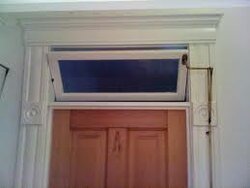Tried to find a previous thread but no luck.
Got a reciprocating saw for Christmas and have been chomping at the bit to try it out just haven't found the right project yet, until now.
I may have mentioned this before, my house has larger than normal door transoms. I've been having issues getting the heat from the stove room past my entrance way/hallway and to the diagonal family room. The 2nd floor stairway goes up right by the entrance way. Getting heat up to the 2nd floor is not an issue at all. Here's my plan:
1) Cut out door transoms in stove room (living room), family room (diagonal to stove room), dining room (connected to family room), and kitchen (connected to dining room).
2) Install some type of grate in all the transoms to make it look pretty. Don't want a massive hole up there.
3) Attach square/rectangle duct work that is the same size as the transom cutout to the ceiling and run it from the stove room transom to the family room transom. From there I'll let the heat lazily make its way to dining room and kitchen.
4) Place a fan in the transom opening in stove room to blow heated air through duct work and into the family room.
5) Use strategically placed floor fans to push cold air into the stove room.
Will this crazy idea work or is it too much air flow. I need to know soon before I start cutting holes in my house. Thanks
Got a reciprocating saw for Christmas and have been chomping at the bit to try it out just haven't found the right project yet, until now.
I may have mentioned this before, my house has larger than normal door transoms. I've been having issues getting the heat from the stove room past my entrance way/hallway and to the diagonal family room. The 2nd floor stairway goes up right by the entrance way. Getting heat up to the 2nd floor is not an issue at all. Here's my plan:
1) Cut out door transoms in stove room (living room), family room (diagonal to stove room), dining room (connected to family room), and kitchen (connected to dining room).
2) Install some type of grate in all the transoms to make it look pretty. Don't want a massive hole up there.
3) Attach square/rectangle duct work that is the same size as the transom cutout to the ceiling and run it from the stove room transom to the family room transom. From there I'll let the heat lazily make its way to dining room and kitchen.
4) Place a fan in the transom opening in stove room to blow heated air through duct work and into the family room.
5) Use strategically placed floor fans to push cold air into the stove room.
Will this crazy idea work or is it too much air flow. I need to know soon before I start cutting holes in my house. Thanks




